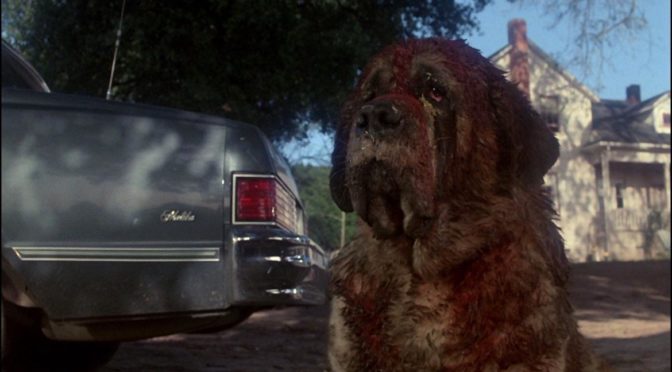“It’s not a monster, it’s just a doggy.”
I’ll be honest, I didn’t know what to expect going into Cujo. As a massive Stephen King fan, I’ve read the book, but it’s been several years so I didn’t remember much beyond the initial premise. But my concern stemmed from the age of the film, pure and simple. Cujo was made in 1983 – would I still find a big dog scary?
Cujo isn’t scary. It’s terrifying. It is quite frankly remarkable how well this film holds up.
At a lean 93 minutes, Cujo could have focused on the titular dog’s attack on Donna and Tad Trenton (Dee Wallace and Danny Pintauro, both terrific), and theoretically sustain its premise. But Cujo has serious, and unexpected, emotional stakes. For one, there’s the dog itself. People love dogs. I love dogs. John Cusack Must Love Dogs. So it’s genuinely upsetting to see Cujo stick his head into a hollowed-out log full of bats, his barks greeted by otherworldly screeches, before he’s bit on the nose, causing him to turn rabid. In a lot of ways, Cujo is like a zombie film, just one that’s about a dog and not a human. He was never a bad dog in “life,” and he falls circumstance to something he had no control over. He may be terrifying, but the audience sympathizes with him.
Likewise, all the business with the Trenton family should feel like wheel-spinning, and in a lesser film it probably would. But the stakes are raised because you root for the Trentons; even if Donna is having an affair with local handyman Steve Kemp (Christopher Stone, Wallace’s real-life husband at the time), she’s still a good mother, and even if Vic (Daniel Hugh Kelly) can get too preoccupied with work, he still says magic words every night to keep monsters out of Tad’s room (“No monsters in Tad’s closet; it’s too small for you in there”). Cujo exists in a deceptively large world; even with Vic hundreds of miles away during Cujo’s attack, he’s still a part of everything that unfolds.
The terror of Cujo comes from a lot of different sources. Donna and Tad are stuck in what seems like a metal coffin, the Trentons’ malfunctioning Pinto. Besides that, they’re not even parked close to the mechanic’s house; surrounded by dirt and broken-down cars, they look like they’re in a graveyard, and the sense of isolation is ever-present. Director Lewis Teague (Cat’s Eye) and his cinematographer Jan de Bont (who went on to direct Speed) keep their camera moving steadily through the dirt lot, letting the audience see from Cujo’s perspective; at times the camera is in the center of the car, showing just how claustrophobic it is, and how the feeling of restriction makes things worse for Donna and Tad.
These bells and whistles, though, would mean nothing if the dog itself didn’t deliver. Thankfully for the film, Cujo is fucking terrifying – no, horrifying. As he grows more and more rabid, his appearance deteriorates until he looks downright monstrous. His fur becomes matted with sweat and blood; his face covered in snot, spittle, and pus. He’s as ghoulish a creation as anything ever conceived by Rick Baker or Stan Winston, and Teague and de Bont make excellent use of his sheer size. Cujo is often framed so that his massive head is taking up the entire frame, and his guttural, full-throated barks are always as loud and intrusive as possible. At times it becomes an almost unbearable onslaught not only for Donna and Tad, but for the audience as well. At one point Cujo climbs up onto the car’s hood and rests his head between his paws, unfeeling, unthinking, but certain of his physical superiority. Something about Cujo waiting is chilling – one of the film’s best shots is of Cujo laying on a porch. He’s not calculating or intelligent like a human; he operates on pure, unreasonable instinct.
Not everything about the film works, to be fair. The conclusion of the Steve Kemp subplot – Donna breaks off the affair, leading Steve to break in and trash the Trentons’ house – is a product of King’s fixation on psychosis lurking below a normal surface, and it might work better in another film, but here it just detracts from the trio of Donna, Tad, and Vic. And obviously the freeze-frame ending is a product of its time. But it says a lot about Cujo that its worst shot doesn’t come until the very end of the film.
Cujo isn’t just surface-level terror. It has a lot to say, through the affair and the attack, about the perversion of domesticity and docility. But for once that doesn’t matter. There’s a reason that the name “Cujo” has become shorthand for any terrifying dog. The film is nasty and relentless – just like an attack dog.
10/1: Dawn of the Dead (2004)
10/2: The Exorcist
10/3: Pontypool
10/4: Hocus Pocus
10/5: The Orphanage
10/6: Rosemary’s Baby
10/7: Alien
10/8: Scream series
10/9: Scream series
10/10: Cujo
10/11: The Cabin in the Woods
10/12: Pulse
10/13: The Babadook
10/14: Friday the 13th
10/15: The Last House on the Left (both versions)
10/16: The Thing (both versions)
10/17: Little Shop of Horrors
10/18: Hush
10/19: Silent Hill
10/20: The Shining
10/21: Funny Games (2007)
10/22: Evil Dead series
10/23: Evil Dead series
10/24: The Mist
10/25: The Ninth Gate
10/26: The Fly
10/27: A Nightmare on Elm Street
10/28: The Nightmare Before Christmas
10/29: 28 Days Later/28 Weeks Later
10/30: It
10/31: Halloween (either version)







